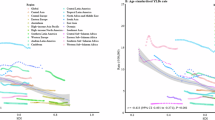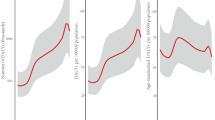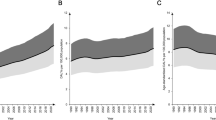Abstract
Background
Cataracts, the leading cause of blindness globally, significantly impair vision and quality of life, particularly among the elderly. Despite advancements in cataract surgery, challenges in accessibility and economic disparities hinder the reduction of cataract burden, especially in low-income regions. This study examines the global prevalence and years lived with disability (YLDs) due to cataracts from 1990 to 2021, providing insights to inform public health strategies.
Methods
Utilizing data from the Global Burden of Disease (GBD) Study 2021, we analysed cataract prevalence and YLDs across 204 countries and territories. The estimates were stratified by age, sex, region, and Socio-Demographic Index (SDI) and compared across different time periods. Age-standardized rates (ASRs) and average annual percentage changes (AAPCs) were calculated to evaluate trends.
Results
From 1990 to 2021, the global YLDs due to cataracts increased from 3.42 million to 6.55 million, a 91.8% rise. Most countries exhibited an increase in YLDs, with notable surges in low-SDI regions like Sub-Saharan Africa and South Asia. The AAPC for age-standardized prevalence rate (ASPR) was slightly positive globally, while the age-standardized YLD rate (ASYR) showed a decreasing trend, indicating improved cataract management. High-SDI regions experienced minor ASPR increases but significant ASYR reductions, reflecting effective interventions. Conversely, low-SDI regions saw declines in both ASPR and ASYR, though disparities persisted.
Conclusion
The burden of cataracts remains substantial, with significant increases in YLDs driven by aging populations and improved diagnostic capabilities. Effective management strategies have reduced ASYRs, particularly in high-SDI regions. Addressing cataract burden in low-SDI regions requires enhanced healthcare access, targeted public health interventions, and global support. These findings underscore the need for continued investment in cataract prevention and treatment to mitigate the global impact.
This is a preview of subscription content, access via your institution
Access options
Subscribe to this journal
Receive 18 print issues and online access
269,00 € per year
only 14,94 € per issue
Buy this article
- Purchase on SpringerLink
- Instant access to full article PDF
Prices may be subject to local taxes which are calculated during checkout





Similar content being viewed by others
Data availability
All data utilized in this study are publicly accessible through the Global Health Data Exchange (GHDX) at the Global Burden of Disease (GBD) 2021 portal. The specific datasets and results can be accessed via the following link: http://ghdx.healthdata.org/gbd-results-tool.
References
Ruiss M, Findl O, Kronschläger M. The human lens: an antioxidant-dependent tissue revealed by the role of caffeine. Ageing Res Rev. 2022;79:101664.
Khairallah M, Kahloun R, Bourne R, Limburg H, Flaxman SR, Jonas JB, et al. Number of people blind or visually impaired by cataract worldwide and in world regions, 1990 to 2010. Investig Ophthalmol Vis Sci. 2015;56:6762–9.
Bourne R. Vision 2020: where are we. Curr Opin Ophthalmol. 2020;31:81–4.
Kwarteng MA, Mashige KP, Kyei S, Dogbe D, Govender-Poonsamy P. Prevalence and causes of visual impairment amongst hearing impaired school-going children in sub-Saharan Africa: a scoping review. Afr Health Sci. 2022;22:199–204.
Burton MJ, Ramke J, Marques AP, Bourne R, Congdon N, Jones I, et al. The Lancet Global Health Commission on Global Eye Health: vision beyond 2020. Lancet Glob Health. 2021;9:e489–551.
Narayan A, Evans JR, O’Brart D, Bunce C, Gore DM, Day AC. Laser-assisted cataract surgery versus standard ultrasound phacoemulsification cataract surgery. Cochrane Database Syst Rev. 2023;6:CD010735.
Yoo SH, Zein M. Vision restoration: cataract surgery and surgical correction of myopia, hyperopia, and presbyopia. Med Clin N Am. 2021;105:445–54.
Lee CM, Afshari NA. The global state of cataract blindness. Curr Opin Ophthalmol. 2017;28:98–103.
Wang W, Yan W, Müller A, He M. A global view on output and outcomes of cataract surgery with national indices of socioeconomic development. Invest Ophthalmol Vis Sci. 2017;58:3669–76.
GBD 2019 Blindness and Vision Impairment Collaborators. Vision Loss Expert Group of the Global Burden of Disease Study. Trends in prevalence of blindness and distance and near vision impairment over 30 years: an analysis for the Global Burden of Disease Study. Lancet Glob Health. 2021;9:e130–43.
GBD 2019 Diseases and Injuries Collaborators. Global burden of 369 diseases and injuries in 204 countries and territories, 1990-2019: a systematic analysis for the Global Burden of Disease Study 2019. Lancet. 2020;396:1204–22.
GBD 2021 Nervous System Disorders Collaborators. Global, regional, and national burden of disorders affecting the nervous system, 1990-2021: a systematic analysis for the Global Burden of Disease Study 2021. Lancet Neurol. 2024;23:344–81.
Liu Y, Li J, Yang G, Meng D, Long X, Wang K. Global burden of inflammatory bowel disease in the elderly: trends from 1990 to 2021 and projections to 2051. Front Aging. 2024;5:1479928.
Aslam MZ, Trail M, Cassell AK 3rd, Khan AB, Payne S. Establishing a sustainable healthcare environment in low- and middle-income countries. BJU Int. 2022;129:134–42.
He M, Wang W, Huang W. Variations and trends in health burden of visual impairment due to cataract: a global analysis. Investig Ophthalmol Vis Sci 2017;58:4299–306.
Global, regional, and national disability-adjusted life-years (DALYs) for 359 diseases and injuries and healthy life expectancy (HALE) for 195 countries and territories, 1990-2017: a systematic analysis for the Global Burden of Disease Study 2017. Lancet. 2018;392:1859–922.
Löfgren S. Solar ultraviolet radiation cataract. Exp Eye Res. 2017;156:112–6.
Haag R, Sieber N, Heßling M. Cataract development by exposure to ultraviolet and blue visible light in porcine lenses. Medicina. 2021;57:535.
Hyder AA, Wali SA, McGuckin J. The burden of disease from neonatal mortality: a review of South Asia and Sub-Saharan Africa. BJOG. 2003;10:894-901.
Li X, Feng X, Sun X, Hou N, Han F, Liu Y. Global, regional, and national burden of Alzheimer’s disease and other dementias, 1990-2019. Front Aging Neurosci. 2022;14:937486.
Kumar V, Jena D, Zahiruddin QS, Roopashree R, Kaur M, Srivastava M, et al. Prostate cancer burden in South Asia: A systematic analysis of global burden of disease data (1990-2021). Int J Urol 2024. https://doi.org/10.1111/iju.15641.
Lewallen S, Thulasiraj RD. Eliminating cataract blindness - how do we apply lessons from Asia to sub-Saharan Africa. Glob Public Health. 2010;5:639–48.
Al-Ghamdi AS. Adults visual impairment and blindness - An overview of prevalence and causes in Saudi Arabia. Saudi J Ophthalmol. 2019;33:374–81.
Zeried FM, Alshalan FA, Simmons D, Osuagwu UL. Visual impairment among adults in Saudi Arabia. Clin Exp Optom. 2020;103:858–64.
Dhalla KA, Guirguis M. Barriers and incentives for conducting research amongst the ophthalmologists in Sub-Sahara Africa. PLoS ONE. 2018;13:e0197945.
Kumar D. Indigenous population genome databases for India and South Asia: emerging need for health and social applications. J Genet 2023;102:46.
Rossi S, Jorge PA, Scherer R, Kara-Junior N. Progression in the Number of Cataract Surgeries in Brazil: 10 Years of Evolution. Ophthalmic Epidemiol 2024:1–8. https://doi.org/10.1080/09286586.2024.2378770.
Author information
Authors and Affiliations
Contributions
ML and XL conceived and designed the study. WJ, JM, YH, MP, JZ, and YZ conducted the data analysis and visualization. XC and XL provided supervision and project administration. ML drafted the manuscript. All authors critically reviewed and revised the manuscript for important intellectual content. ML, WJ and JM contributed equally to this work. All authors approved the final version of the manuscript for submission.
Corresponding authors
Ethics declarations
Competing interests
The authors declare no competing interests.
Additional information
Publisher’s note Springer Nature remains neutral with regard to jurisdictional claims in published maps and institutional affiliations.
Rights and permissions
Springer Nature or its licensor (e.g. a society or other partner) holds exclusive rights to this article under a publishing agreement with the author(s) or other rightsholder(s); author self-archiving of the accepted manuscript version of this article is solely governed by the terms of such publishing agreement and applicable law.
About this article
Cite this article
Li, M., Jia, W., Song, J. et al. Global prevalence and years lived with disability (YLDs) of cataract in 204 countries and territories: findings from the Global Burden of Disease Study 2021. Eye 39, 1737–1743 (2025). https://doi.org/10.1038/s41433-025-03743-z
Received:
Revised:
Accepted:
Published:
Issue Date:
DOI: https://doi.org/10.1038/s41433-025-03743-z



